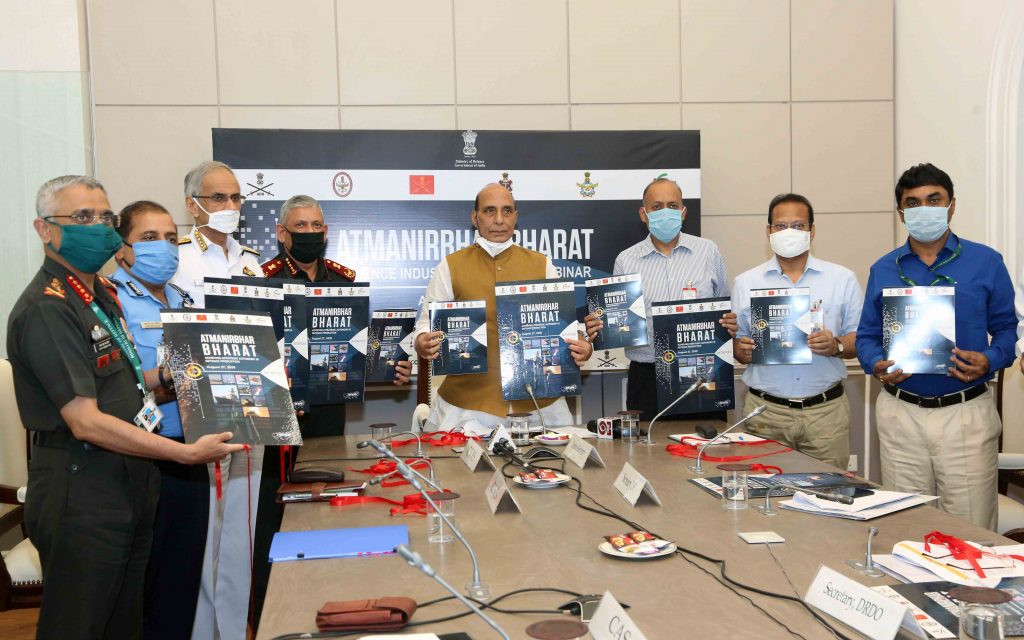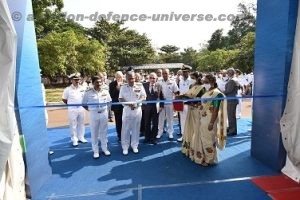
- Rs 52,000 crore has been set aside for procurement from domestic vendors
- All capital acquisition projects below 100 crores are reserved for MSMEs
- Project Management Unit to be operative from September
New Delhi. 28 August 2020. Defence sector has already been identified as one of the core areas to boost ‘Make in India’ where immediate transformation is required. Prime Minister Narendra Modi also spelt out his vision of achieving five billion USD (Rs35,000 crore) defence related exports target to become net exporter of defence equipment in the next five years. Addressing the webinar ‘Atmanirbhar Bharat – Defence Industry Outreach’, organized by FICCI, jointly with the Department of Military Affairs (DMA), Ministry of Defence, PM Modi said, “ India has the capability to become a trusted supplier of defence equipment for its friendly countries. “We all collectively have to achieve the target of Atmanirbhar Bharat. It is a win-win situation for everyone including the public sector, private sector and foreign companies. The government is committed to providing a better eco-system.”
Defence Minister of India Rajnath Singh listed out the salient features of the recently announced first Defence Production and Export Promotion policy at the Atmanirbhar Bharat Defence Industry Outreach Webinar. He added that the ministry has allocated Rs 52,000 crore from the defence budget for the current financial year to boost and promote domestic defence industries. He also laid emphasis on simplifying the procurement procedures and reducing the timelines for approvals. He further added that the government is working on the process of corporatization of the Ordinance Factory Boards in the country, which will further strengthen the defence sector.
He said, “ self reliance has been a part of Indian culture and tradition of India and is a national call. Bold policy reforms like defence corridors, 74 % FDI and corporatisation of Ordnance Factories. Embargo in 101 items from import. 15% budget increase every year is also on the cards. MRO and aerospace hubs are priority. Stakes higher, gestation period long. Within an year corporatisation of OFB will happen. Project Mgt Unit is in final stages of approval and within this week we will have this unit in place. RFP on first strategic partnership production is expected to be issued very soon and it is in legal whetting. SP model has PSUs participation in them. All capital acquisition projects below 100 crores are reserved for MSMEs.”
Gen Bipin Rawat, Chief of Defence Staff said that after consultation with the industry, there are a lot of items that they want to be added in the negative list. “The list is going to increase, and we will have the next list by early next year. That will not be the end of the list. Gradually, as we see the private industry delivering, we will keep on adding more items to the list. The Indian aerospace industry will find it’s feet in India and that this is one area where we are lagging. Putting them in the negative list will be one of our greatest achievements,” he stated.
“As India grows security challenges are bound to increase. Boost indigenisation by in-house R&D. We are incorrectly perceived to have an export bias which is incorrect. Promoting indignisation is the government’s priority. Startups hold the key to innovation and academia volunteer as incubators. Project less than 100 Crores are reserved for MSMEs and Start Ups. DRDO has also released a list of TOTs which the industry can take for manufacturing. We wish from the industry to utilise the DRDO and partner with it,” he said.
Raj Kumar, Secretary, Department of Defence Production, Ministry of Defence said, “ the proof of Atmanirbharta lies in our ability to export our defence products. With the help of the defence attachés, we have developed country profiles of friendly nations. We propose that with due facilitation by defence attaché and Indian embassies will help us promote export of our indigenous products. Make in India to Make for World is our motto. Ability to produce what our forces need but also to design and development what they need is our need. RFPs should reflect long term demand, streamline trial and testing procedures which will help in framing of GSQR. Co-production model with OEMs is the need of the times. DAP, IDEX, Start Ups will help in identifying and developming of cutting edge technologies.” His most important clarification was the Indian vendor means foreign subsidiaries, 100 % Indian companies and Joint Ventures.
Prof K Vijay Raghavan, Principal Scientific Advisor, Govt of India, said that the government has set up the Empowered Technology group, which will ensure that we develop high-end technology locally, within India. He further added that design, development and prototyping in detail through traditional manufacturing will be the key to promoting the sector. “All components which go into defence manufacturing have dual use. This can create a big market. Detailed and dynamic maps of our core capabilities should be made. Design, developing and prototyping are the key and help to manufacture both indigenously and by industry abroad. DRDO, academia and industry participation are a must. Setting up targets and meeting those targets is another issue which needs to be looked into. Global supply chain can be developed where innovators and users say is important,” he reiterated.
S P Shukla, Chairman, FICCI Defence and Aerospace Committee and Chairman, Mahindra Defence said that the Indian defence sector will give its full support in achieving the target of both reaching the $ 5 trillion target and becoming Atmanirbhar Bharat and create new job opportunities. He added, “ creating jobs for our bright students and engineers is a priority. In US defence and aerospace industry is the largest employer and employs more than 25 lakh people. Account for 150Bn USD in exports and 60 Bn USD in taxes. In India our DPSUs employ about 1.5 lakh approximately. Job creation in Aircraft , ships and land systems manufacturing with signals and communication industry. Training & Maintenance also create jobs. Job creation is top priority for any government in power”
Baba N Kalyani, Chairman and Managing Director, Bharat Forge Limited said that achieving Atmanirbharta in the defence sector is a continuous journey and not a destination. All stakeholders including the industry, policymakers, researchers and academia have to work together to achieve this. He reflected, “ Big fast changes happen only when there is necessity. Crisis can be converted into an opportunity. India will infact be the prime mover of economy. Defence and aerospace will drive the new growth in the industry. Path breaking and transformational announcements under make in India will help Indian industry to move forward in consultation with the armed forces to develop a defence ecosystem in the country. Setting up a realistic GSR has been a great asset. Fast track acquisition procedure for items having got AONs. Speeding up procurement cycle is a need. ”
Dr Sangita Reddy, President, FICCI said that the new draft Defence Acquisition Procedure 2020 is an important move towards self-reliance. “Indian defence sector is one of the important drivers of the engine of growth and can raise the contribution of manufacturing from 16 per cent of GDP to a target of 25 per cent,” she added.
The FICCI webinar which had representation from all three Services, MoD, DRDO and industry covered energising strategies to develop niche tech and promote culture of innovations. It was decided to develop large eco system with well-defined role for all stake holders/ MSMEs as tier-II / tier-III suppliers, start-ups and academia as innovators, industry houses as aggregators, testing & quality assurance services providers. To achieve the envisioned goal, Webinar encouraged innovation to make in India as an integral part of Global Supply Chain and top class destination for manufacture of defence equipment. It stressed to develop world class testing and evaluation infrastructure by utilising existing infrastructure with DRDO and private industry. The participants also discussed ways to develop manufacturing and sustenance eco system to help in life cycle support of indigenous equipment.























































































































